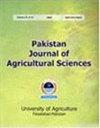Nitrogen application rate and timing management for improved grain quality parameters of wheat crop
IF 0.7
4区 农林科学
Q3 AGRICULTURE, MULTIDISCIPLINARY
引用次数: 3
Abstract
Nitrogen use efficiency under flood irrigation system is generally low (30%) in field crops, which is one of the fundamental factors of high production cost in the developing countries. Optimum rate and timing of N-application is otherwise important to harvest good quality grain for backing in the recent climate change scenario. Optimum N-rate (NAR) corresponds with the application timing (NAT) has resulted in good quality grains. Aim of the study was to focus on spring wheat grain quality and N use efficiency (NUE) with NAR {i.e., 0, 100, 120, 140 and 160 kg ha-1) and NAT (i.e., 100% at sowing (NAR1), 50% at sowing and 50% at tillering (NAT2), 25% at sowing, 50% at tillering and 25% at booting (NAT3) and 25% at sowing, 25% at tillering and 50% at booting (NAT4)}. Treatment impacts were investigated focusing grain yield, grain-N, and quality parameters (i.e., crude protein, gluten, amylose and amylopectin). Experiment was a randomized complete block, in three replications, conducted at Agronomy Res. Farm of the University of Agric. Peshawar in 2016-17 and repeated in 2017-18. Results showed the highest NUE in100 kg N ha-1, followed by a decreasing rate (p<0.05) for every next N-increment. While averaged on N-rates, the highest NUE observed in NAT3 which did not differ fromNAT4 but decreased (p<0.05) for treatment NAT2 with lowest for theNAT1. Pakhtunkhuwa-2015 showed higher NUE among the varieties. Grain-N, grain yield, gluten and amylose did not differ with NAR 140 and 160 kg ha-1 as well as for the NAT3 and NAT4 but decreased for NAT2 and the lowest was noted for NAT1. The N-content of wheat grain was highest in Pakhtunkhuwa-2015, followed by Pirsabak-2015 and the lowest in DN-84. Nonetheless, grain amylopectin showed a reduction with increasing NAR and/or split N-applications from one to two and/or three doses. Cultivars did not show any changes in the amylopectin. It is concluded that in recent climate changes where flood irrigation system is practiced, three N-splits (NAT3 or NAT4) resulted higher quality grains with140 kg N ha-1 to wheat crop提高小麦品质参数的施氮量和定时管理
农田作物在漫灌系统下氮素利用效率普遍较低(30%),这是发展中国家生产成本高的根本因素之一。此外,在最近的气候变化情况下,最佳的施氮速率和时机对于收获优质粮食至关重要。最佳施氮量与施肥时机相适应,可获得优质籽粒。本研究的目的是利用NAR{即NAR{对春小麦籽粒品质和氮素利用效率进行研究。(0、100、120、140和160 kg ha-1)和NAT(即播种时100% (NAR1),播种时50%分蘖时50% (NAT2),播种时25%,分蘖时50%,孕穗期25% (NAT3),播种时25%,分蘖时25%,孕穗期50% (NAT4))}。以籽粒产量、籽粒氮和品质参数(即粗蛋白、面筋、直链淀粉和支链淀粉)为重点,研究了处理的影响。实验采用随机完全区组,分三个重复,在农业大学农学研究院农场进行。2016-17年在白沙瓦,2017-18年重复。结果表明:100 kg N ha-1时氮肥利用率最高,随N的增加而降低(p<0.05);在平均施氮率下,处理NAT3的氮素利用效率最高,与处理nat4无显著差异,但处理NAT2的氮素利用效率降低(p<0.05),处理nat1的氮素利用效率最低。Pakhtunkhuwa-2015品种的氮肥利用效率较高。籽粒氮素、籽粒产量、面筋和直链淀粉在NAR 140和160 kg ha-1以及NAT3和NAT4处理中无显著差异,但在NAT2处理中有所降低,以NAT1处理最低。小麦籽粒氮含量以“普赫图赫瓦-2015”最高,“皮尔萨巴克-2015”次之,“DN-84”最低。尽管如此,谷物支链淀粉的含量随着NAR的增加和/或分施氮量从一次增加到两次和/或三次而减少。不同品种支链淀粉含量无明显变化。综上所述,在近期气候变化条件下,采用3次氮素分流(NAT3或NAT4)可提高小麦籽粒品质,且氮素水平为140 kg hm -1
本文章由计算机程序翻译,如有差异,请以英文原文为准。
求助全文
约1分钟内获得全文
求助全文
来源期刊

Pakistan Journal of Agricultural Sciences
AGRICULTURE, MULTIDISCIPLINARY-
CiteScore
1.80
自引率
25.00%
发文量
18
审稿时长
6-12 weeks
期刊介绍:
Pakistan Journal of Agricultural Sciences is published in English four times a year. The journal publishes original articles on all aspects of agriculture and allied fields.
 求助内容:
求助内容: 应助结果提醒方式:
应助结果提醒方式:


